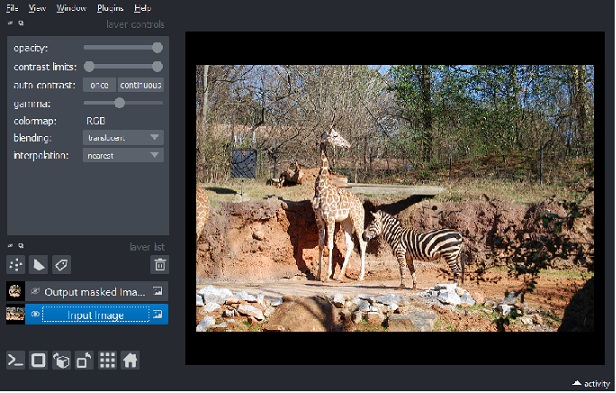
- Scikit Image – Introduction
- Scikit Image - Image Processing
- Scikit Image - Numpy Images
- Scikit Image - Image datatypes
- Scikit Image - Using Plugins
- Scikit Image - Image Handlings
- Scikit Image - Reading Images
- Scikit Image - Writing Images
- Scikit Image - Displaying Images
- Scikit Image - Image Collections
- Scikit Image - Image Stack
- Scikit Image - Multi Image
- Scikit Image - Data Visualization
- Scikit Image - Using Matplotlib
- Scikit Image - Using Ploty
- Scikit Image - Using Mayavi
- Scikit Image - Using Napari
- Scikit Image - Color Manipulation
- Scikit Image - Alpha Channel
- Scikit Image - Conversion b/w Color & Gray Values
- Scikit Image - Conversion b/w RGB & HSV
- Scikit Image - Conversion to CIE-LAB Color Space
- Scikit Image - Conversion from CIE-LAB Color Space
- Scikit Image - Conversion to luv Color Space
- Scikit Image - Conversion from luv Color Space
- Scikit Image - Image Inversion
- Scikit Image - Painting Images with Labels
- Scikit Image - Contrast & Exposure
- Scikit Image - Contrast
- Scikit Image - Contrast enhancement
- Scikit Image - Exposure
- Scikit Image - Histogram Matching
- Scikit Image - Histogram Equalization
- Scikit Image - Local Histogram Equalization
- Scikit Image - Tinting gray-scale images
- Scikit Image - Image Transformation
- Scikit Image - Scaling an image
- Scikit Image - Rotating an Image
- Scikit Image - Warping an Image
- Scikit Image - Affine Transform
- Scikit Image - Piecewise Affine Transform
- Scikit Image - ProjectiveTransform
- Scikit Image - EuclideanTransform
- Scikit Image - Radon Transform
- Scikit Image - Line Hough Transform
- Scikit Image - Probabilistic Hough Transform
- Scikit Image - Circular Hough Transforms
- Scikit Image - Elliptical Hough Transforms
- Scikit Image - Polynomial Transform
- Scikit Image - Image Pyramids
- Scikit Image - Pyramid Gaussian Transform
- Scikit Image - Pyramid Laplacian Transform
- Scikit Image - Swirl Transform
- Scikit Image - Morphological Operations
- Scikit Image - Erosion
- Scikit Image - Dilation
- Scikit Image - Black & White Tophat Morphologies
- Scikit Image - Convex Hull
- Scikit Image - Generating footprints
- Scikit Image - Isotopic Dilation & Erosion
- Scikit Image - Isotopic Closing & Opening of an Image
- Scikit Image - Skelitonizing an Image
- Scikit Image - Morphological Thinning
- Scikit Image - Masking an image
- Scikit Image - Area Closing & Opening of an Image
- Scikit Image - Diameter Closing & Opening of an Image
- Scikit Image - Morphological reconstruction of an Image
- Scikit Image - Finding local Maxima
- Scikit Image - Finding local Minima
- Scikit Image - Removing Small Holes from an Image
- Scikit Image - Removing Small Objects from an Image
- Scikit Image - Filters
- Scikit Image - Image Filters
- Scikit Image - Median Filter
- Scikit Image - Mean Filters
- Scikit Image - Morphological gray-level Filters
- Scikit Image - Gabor Filter
- Scikit Image - Gaussian Filter
- Scikit Image - Butterworth Filter
- Scikit Image - Frangi Filter
- Scikit Image - Hessian Filter
- Scikit Image - Meijering Neuriteness Filter
- Scikit Image - Sato Filter
- Scikit Image - Sobel Filter
- Scikit Image - Farid Filter
- Scikit Image - Scharr Filter
- Scikit Image - Unsharp Mask Filter
- Scikit Image - Roberts Cross Operator
- Scikit Image - Lapalace Operator
- Scikit Image - Window Functions With Images
- Scikit Image - Thresholding
- Scikit Image - Applying Threshold
- Scikit Image - Otsu Thresholding
- Scikit Image - Local thresholding
- Scikit Image - Hysteresis Thresholding
- Scikit Image - Li thresholding
- Scikit Image - Multi-Otsu Thresholding
- Scikit Image - Niblack and Sauvola Thresholding
- Scikit Image - Restoring Images
- Scikit Image - Rolling-ball Algorithm
- Scikit Image - Denoising an Image
- Scikit Image - Wavelet Denoising
- Scikit Image - Non-local means denoising for preserving textures
- Scikit Image - Calibrating Denoisers Using J-Invariance
- Scikit Image - Total Variation Denoising
- Scikit Image - Shift-invariant wavelet denoising
- Scikit Image - Image Deconvolution
- Scikit Image - Richardson-Lucy Deconvolution
- Scikit Image - Recover the original from a wrapped phase image
- Scikit Image - Image Inpainting
- Scikit Image - Registering Images
- Scikit Image - Image Registration
- Scikit Image - Masked Normalized Cross-Correlation
- Scikit Image - Registration using optical flow
- Scikit Image - Assemble images with simple image stitching
- Scikit Image - Registration using Polar and Log-Polar
- Scikit Image - Feature Detection
- Scikit Image - Dense DAISY Feature Description
- Scikit Image - Histogram of Oriented Gradients
- Scikit Image - Template Matching
- Scikit Image - CENSURE Feature Detector
- Scikit Image - BRIEF Binary Descriptor
- Scikit Image - SIFT Feature Detector and Descriptor Extractor
- Scikit Image - GLCM Texture Features
- Scikit Image - Shape Index
- Scikit Image - Sliding Window Histogram
- Scikit Image - Finding Contour
- Scikit Image - Texture Classification Using Local Binary Pattern
- Scikit Image - Texture Classification Using Multi-Block Local Binary Pattern
- Scikit Image - Active Contour Model
- Scikit Image - Canny Edge Detection
- Scikit Image - Marching Cubes
- Scikit Image - Foerstner Corner Detection
- Scikit Image - Harris Corner Detection
- Scikit Image - Extracting FAST Corners
- Scikit Image - Shi-Tomasi Corner Detection
- Scikit Image - Haar Like Feature Detection
- Scikit Image - Haar Feature detection of coordinates
- Scikit Image - Hessian matrix
- Scikit Image - ORB feature Detection
- Scikit Image - Additional Concepts
- Scikit Image - Render text onto an image
- Scikit Image - Face detection using a cascade classifier
- Scikit Image - Face classification using Haar-like feature descriptor
- Scikit Image - Visual image comparison
- Scikit Image - Exploring Region Properties With Pandas
Scikit Image - Using Napari
Scikit Image with Napari
Napari is a powerful Python library for n-dimensional image visualization, annotation, and analysis. It provides a flexible and interactive environment for working with image data. Following are some key features and capabilities of Napari −
- Viewing and Exploring − Napari allows you to view and explore n-dimensional arrays on a canvas. It supports 2D, 3D, and higher-dimensional data, providing a responsive and interactive visualization experience.
- Overlay derived data − Napari enables you to overlay derived data such as points, polygons, segmentations, labels, and more.
- Annotation and Editing − Napari provides tools for annotating and editing the derived datasets. You can add, modify, or delete annotations interactively using a variety of tools. Napari integrates with standard data structures like NumPy or Zarr arrays, enabling efficient annotation and analysis workflows.
And it is a fast, interactive viewer for multi-dimensional images in Python. Also, it provides a user-friendly interface, extensive customization options, and the ability to integrate with other scientific Python libraries.
Installation of Napari
To use Napari, you will need the following requirements −
- Python > = 3.8 − Napari requires Python version 3.8 or higher. Make sure you have a compatible version installed on your system.
- Ability to Install Python Packages − You should have the ability to install Python packages using either pip or conda-forge. These are package managers that allow you to easily install and manage Python libraries and dependencies.
Additionally, it is recommended to have −
Environment Manager (such as Conda) − While not strictly required, having an environment manager like Conda can be beneficial. Conda allows you to create isolated Python environments. It provides a convenient way to manage your Python environment and ensure compatibility with other libraries and tools.
Installing Napari using pip
To install Napari using pip, just run the following command in your command prompt −
python -m pip install "napari[all]"
Installing Napari using Conda-Forge
If you're using the Anaconda distribution already in your system then you can directly install napari from the conda-forge channel. Following is the command −
conda install -c conda-forge napari
Once Napari is installed, you can use it in your Python scripts. Below are a few basic Python programs that demonstrate how to use the Napari library along with scikit-image to perform data visualization tasks effectively.
Example 1
The following example demonstrates how to display an image using the Viewer() method in the Napari library.
import napari
from skimage import io
# Read an image
image = io.imread('Images/logo-w.png')
# Display the image using Napari
viewer = napari.Viewer()
viewer.add_image(image, name='Tutorialspoint')
Output
On executing the above program, you will get the following output −

Example 2
The following example demonstrates how to apply a circular mask to an image using scikit-image and display the original image and the masked images using the Napari library.
import napari from skimage import io # Load the image image_path = 'Images_/Zoo.jpg' image = io.imread(image_path) image_copy = np.copy(image) # Create circular mask rows, cols, _ = image.shape row, col = np.ogrid[:rows, :cols] center_row, center_col = rows / 2, cols / 2 radius = min(rows, cols) / 2 outer_disk_mask = ((row - center_row)**2 + (col - center_col)**2 > radius**2) # Apply mask to image image[outer_disk_mask] = 0 # Display the image using Napari viewer = napari.Viewer() viewer.add_image(image_copy, name='Input Image') viewer.add_image(image, name='Output masked Image')
Output
On executing the above program, you will get the following output −
